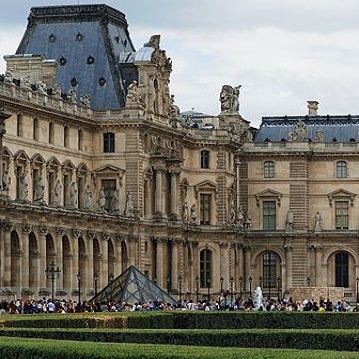
Louvre. The Louvre, or the Louvre Museum, is the world's largest art museum and a historic monument in Paris, France.
A central landmark of the city, it is located on the Right Bank of the Seine in the city's 1st arrondissement. Approximately 38,000 objects from prehistory to the 21st century are exhibited over an area of 72,735 square metres.
In 2018, the Louvre was the world's most visited art museum, receiving 10.2 million visitors. The museum is housed in the Louvre Palace, originally built as the Louvre castle in the late 12th to 13th century under Philip II. Remnants of the fortress are visible in the basement of the museum.
Due to urban expansion, the fortress eventually lost its defensive function, and in 1546 Francis I converted it into the main residence of the French Kings. The building was extended many times to form the present Louvre Palace.
In 1682, Louis XIV chose the Palace of Versailles for his household, leaving the Louvre primarily as a place to display the royal collection, including, from 1692, a collection of ancient Greek and Roman sculpture. In 1692, the building was occupied by the Acad�mie des Inscriptions et Belles-Lettres and the Academie Royale de Peinture et de Sculpture, which in 1699 held the first of a series of salons. The Academie remained at the Louvre for 100 years. During the French Revolution, the National Assembly decreed that the Louvre shoul
A central landmark of the city, it is located on the Right Bank of the Seine in the city's 1st arrondissement. Approximately 38,000 objects from prehistory to the 21st century are exhibited over an area of 72,735 square metres.
In 2018, the Louvre was the world's most visited art museum, receiving 10.2 million visitors. The museum is housed in the Louvre Palace, originally built as the Louvre castle in the late 12th to 13th century under Philip II. Remnants of the fortress are visible in the basement of the museum.
Due to urban expansion, the fortress eventually lost its defensive function, and in 1546 Francis I converted it into the main residence of the French Kings. The building was extended many times to form the present Louvre Palace.
In 1682, Louis XIV chose the Palace of Versailles for his household, leaving the Louvre primarily as a place to display the royal collection, including, from 1692, a collection of ancient Greek and Roman sculpture. In 1692, the building was occupied by the Acad�mie des Inscriptions et Belles-Lettres and the Academie Royale de Peinture et de Sculpture, which in 1699 held the first of a series of salons. The Academie remained at the Louvre for 100 years. During the French Revolution, the National Assembly decreed that the Louvre shoul
Wikipedia ...